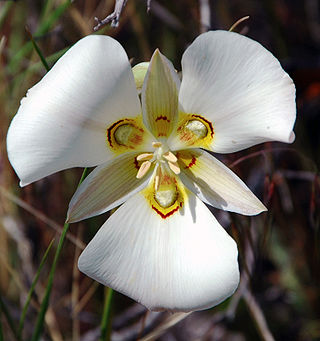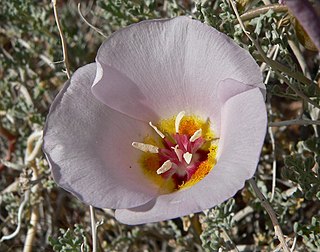
Calochortus is a genus of flowering plants in the lily family. The group includes herbaceous, perennial and bulbous species, all native to North America.

Calochortus flexuosus is a species of lily known by the common names winding Mariposa lily and straggling Mariposa lily.

Calochortus macrocarpus, also known as sagebrush mariposa lily, is a North American species of bulbous perennials in the lily family.

Calochortus albus is a North American species in the genus Calochortus in the family Liliaceae. It is also known by the common names fairy lantern, white fairy lantern, pink fairy lantern, lantern of the fairies, globe lily, white globe lily, white globe-tulip, alabaster tulip, Indian bells,satin bells, snowy lily-bell, and snow drops.

Calochortus amabilis is a species of the genus Calochortus in the family Liliaceae. It is also known by the common names Diogenes' lantern, yellow globe-tulip, golden globe-tulip, yellow globe lily, golden fairy lantern, golden lily-bell, Chinese lantern, and short lily.

Calochortus elegans is a species of flowering plant in the lily family known by the common name elegant Mariposa lily, cat's ear, elegant cat's ears or star tulip. It is native to the western United States from northern California to Montana.

Calochortus venustus is a California species of flowering plants in the lily family known by the common name butterfly mariposa lily. It is a perennial herb that grows in grasslands and open wooded areas.

Calochortus weedii is a North American species of flowering plants in the lily family known by the common name Weed's mariposa lily.

Calochortus syntrophus is a rare species of flowering plant in the lily family known by the common names Callahan's mariposa lily and clustered mariposa lily. It is endemic to northern California, where it occurs in a remote area north of Montgomery Creek in Shasta County. It has also been spotted in adjacent Tehama County. Its habitat includes open, rocky areas with moist or wet soils in oak woodland territory. It was first discovered in 1993 and its description was published the following year.

Calochortus fimbriatus is a California species of flowering plant in the lily family known by the common name late-blooming mariposa lily. It is native to the coastal mountain ranges of southern Monterey, San Luis Obispo, Santa Barbara and northern Ventura counties, where it is a member of the chaparral flora.

Calochortus howellii, or Howell's mariposa lily, is a rare North American species of flowering plants in the lily family, found only in Josephine and Curry Counties in south-western Oregon.

Calochortus subalpinus, the subalpine mariposa lily, is a North American species of flowering plants in the lily family native to the northwestern United States.

Calochortus barbatus is a species of mariposa lilies in the lily family. It is endemic to Mexico.
Calochortus balsensis is a Mexican species of flowering plants in the lily family. It is native to the States of Guerrero and Oaxaca in the southwestern part of the country.
Calochortus exilis is a rare Mexican species of plants in the lily family. It is native to mountains in the State of Hidalgo in east-central Mexico.

Calochortus longibarbatus is a species of flowering plant in the lily family with the common names long-haired star-tulip and longbeard mariposa lily. It is native to Oregon, Washington, and northern California, where it grows in the forest and woodlands of the mountains.

Calochortus lyallii, or Lyall's mariposa lily, is a North American species of flowering plant in the lily family. It is native and endemic to Province of British Columbia in western Canada, as well as the State of Washington in the northwestern United States. It only grows east of the Cascade crest in the mountains and foothills, and though its numbers are apparently secure in Washington, it is considered to be a blue-listed species in Canada- blue-listed taxa are at risk, but are not extirpated, endangered or threatened. It is found in dry to mesic open forest at lower to middle elevations in the mountains, commonly found with Pinus ponderosa, Pseudotsuga menziesii, Calamagrostis rubescens (pinegrass) and Carex geyeri.
Calochortus ghiesbreghtii is a Mesoamerican species of plants in the lily family. It is native to Guatemala and to the States of Hidalgo and Chiapas in Mexico.
Calochortus spatulatus is a Mexican species of plants in the lily family. It is widespread across much of Mexico from Sonora and Chihuahua south as far as Oaxaca.
Calochortus foliosus is a bulbous plant of the lily family. It is sometimes known by the common name leafy cyclobothra and belongs to subsection Purpurei within section Cyclobothra in the genus Calochortus. It occurs in mountainous central Mexico. Little is known about the species aside from the information provided in the original description.
















